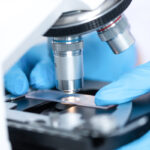Non-Surgical Fibroid Treatment

İçindekiler
ToggleFibroids affect one in four women. They are tumors that cause menstrual irregularity, pain, infertility, and frequent urination in women. If not treated properly, it may even lead to the loss of the uterus. Fibroids can be treated surgically. However, in recent years, thanks to non-surgical treatment methods, fibroids have been eliminated in a more comfortable way.
One of the non-surgical fibroid treatments is fibroid embolization, and the other is non-surgical acoustic fibroid treatment. Fibroid embolization is successfully performed in interventional radiology units in advanced diagnostic and treatment centers. In this treatment, the vessels feeding the fibroid are closed with occlusive substances, the nutrition of the fibroid is cut off, and the fibroids are destroyed. In acoustic fibroid treatment, fibroids are destroyed with heat using sound waves.
What Are Non-Surgical Fibroid Treatments?
Acoustic Fibroid Treatment
This treatment method, applied by means of sound waves, has been successfully performed in many women. Without the need for surgery and without the patient receiving anesthesia, if applied to properly selected patients, fibroids can be successfully eliminated.
A small region inside the fibroid is focused with targeted sound waves. The fibroid tissue there is heated to 60–70 degrees using high energy and destroyed. While this process is carried out, it is not possible for surrounding tissues or skin to be damaged. To visualize the targeted area precisely, magnetic resonance imaging (MRI) is continuously used during the procedure. In planning this treatment, it is possible to identify the target tissue to be treated and to protect important tissues such as nerves around the fibroid. MRI is the only method that can show the temperature changes occurring in the body. Thanks to this heat map, which provides continuous imaging during the procedure, the required temperature is reached and it is ensured that this temperature is not exceeded. At the same time, it is continuously monitored whether the tissue has been sufficiently destroyed. This application does not involve radiation and provides real-time imaging during the procedure. For the patient, only a mild painkiller or sedative is given during the procedure for comfort. This treatment is completed within about two hours, raises the woman’s quality of life, reduces treatment costs, causes less pain, and allows the patient to return to her normal life immediately after leaving the hospital.
What Are the Advantages of Acoustic Fibroid Treatment?
- The treatment is completed in about two hours
- No incision is made in the abdominal area and there is no need for anesthesia
- The patient can be treated on an outpatient basis
- Patients do not experience any problems in subsequent pregnancies
- Since recovery is very fast, the patient returns to normal life earlier
- The patient’s quality of life is maximally considered in the treatment
Who Can Undergo Acoustic Fibroid Treatment?
- If the patient has fibroid-related complaints
- If the size and location of fibroids are within reach of the MR-HIFU device
- If the number of fibroids is fewer than five
- If the fibroids are 10 cm or smaller in size
- If the patient prefers a non-surgical treatment method for fibroids
Which Types of Fibroids Cannot Be Treated with Acoustic Fibroid Therapy?
- Malignant tumors
- Fibroids during pregnancy
- In the presence of acute infection
- When the number of fibroids is more than five
- When the size of the fibroids is larger than 10 cm
- In cases where large surgical scars or intestines in front block the passage of sound waves
- If there is a contrast agent allergy
- In the treatment of pedunculated fibroids
- In conditions that prevent MRI from being performed
Acoustic fibroid treatment can be successfully applied in 25% of fibroid patients. The entire procedure is completed in about 4 hours. During the treatment process, patients are given only intravenous sedatives. Patients are evaluated with a gynecological examination and MRI to determine whether their fibroid is suitable for this treatment. After treatment, the patient undergoes gynecological examinations at 6, 12, and 18 months. MRI scans are repeated if necessary.
Fibroid Embolization Treatment
Embolization is one of the non-surgical treatment methods for fibroids located in the uterus. It is a treatment performed through the vessels and does not require surgical intervention. With this treatment, the uterus is preserved and fibroids are successfully treated. Patients are relieved of fibroid problems in a very comfortable way.
During embolization treatment, with the help of angiography, a needle is inserted into the patient’s groin vessel and a very thin catheter is advanced into the artery feeding the uterus and the fibroid. After this, the vessels are blocked with special devices, cutting off the fibroid’s blood supply. With this treatment, symptoms are eliminated in 90% of patients.
What Are the Advantages of Fibroid Embolization Treatment?
- Since this treatment is applied with local anesthesia, it affects patients less compared to other surgical treatments
- As there is no need for general anesthesia, there is no intensive care process after treatment. The patient can go directly to bed after the procedure
- No incision or stitches are required in the patient’s body. The procedure is done only by inserting a needle into the vessel. There is no blood loss during this process, and the integrity of the organs is completely preserved
- Patients can return to daily life in a very short time after treatment
- Research in this area has shown complete recovery in 90% of patients. Fibroids regress to quite small sizes over time
- Multiple fibroids in the uterus can be treated with this method
- When performed by an experienced interventional radiologist, fibroid embolization carries no significant risk other than minor clinical concerns
Limitations of Fibroid Embolization Treatment
- After embolization treatment, patients may experience temporary pain, but this can be controlled with intravenous medication
- In patients with allergic tendencies, it should be applied with special precautions
- Preventive measures must be taken against infection after the procedure
- In almost half of the patients, fibroid tissue fragments may pass as discharge. If the fibroid is close to the uterine cavity, this is more effective. Rarely, curettage may be required for larger remaining fragments
- In most patients, normal menstrual cycles resume shortly after fibroid embolization. In about 5% of women over the age of 45, menstruation may stop
- In a small group of patients (about 1%), the treatment may not be successful, and different treatments may be needed
- There is no definitive information about whether women can have children again after embolization. However, it is known that some women who underwent this treatment later became pregnant and gave birth
Which Patients Cannot Undergo Fibroid Embolization Treatment?
Non-surgical fibroid embolization cannot be performed on women without fibroid-related symptoms. It cannot be applied in inflammatory diseases or in fibroids suspected to be cancerous. If there is a possibility of pregnancy, this treatment also cannot be performed. In women with iodine allergy or chronic kidney disease, fibroid embolization treatment can be applied only with special precautions when necessary.
Stages of Fibroid Embolization Treatment
Before starting treatment, ultrasound and MRI (magnetic resonance imaging) are performed to examine the uterus, reproductive organs, and fibroids. Organ relations are evaluated, and the patient undergoes a detailed examination. Medications used, allergies, and medical history are reviewed. The patient is also questioned about the possibility of pregnancy. Once everything is found suitable, the appropriate plan for treatment is made.
On the morning of the procedure, the patient must be fasting. Local anesthesia is sufficient for this treatment. However, for the patient to be comfortable and relaxed, anesthesia should be administered by an anesthesiologist. Embolization treatment must be performed in the angiography room of the interventional radiology unit. The patient is placed under sterile conditions and covered. A needle is inserted into the femoral artery in the groin. Then, with a fine catheter, contrast dye is injected into the artery for imaging. After detailed evaluation of the uterine vessels and visualization of the fibroid, a fine catheter is advanced into the artery feeding the fibroid. A special micron-sized substance is delivered into this artery, cutting off the fibroid’s blood supply. Since fibroids are supplied from both sides of the uterus, the same procedure is applied to the other side as well.
Once the embolization is finished, angiography is performed again to check the procedure. If successful, the catheter is removed. Manual pressure is applied to the artery where the catheter was inserted to prevent bleeding. As in other angiography procedures, the patient is rested in bed to allow the artery to heal.
Fibroid embolization is completed within only one hour. The necessary checks are performed, and the patient is taken to her room for bed rest. The next day, the patient is re-evaluated, and if appropriate, prescribed medications and discharged.
For the next few days, patients may feel fatigue, abdominal and pelvic pain, mild fever, or intermittent cramping, which is normal and controlled with medications. The next day, the patient should be able to walk and perform light daily activities, but must avoid overexertion or heavy work. A vaginal discharge may continue for a few weeks but gradually decreases. Significant fibroid shrinkage is not expected in the first few months; softening and shrinkage begin later. Complaints related to fibroids then diminish. During this healing process, the patient is kept in regular contact and necessary follow-ups are ensured. The full positive effects of the treatment appear within six months. At the end of this period, MRI is performed, and the fibroids are re-evaluated.






